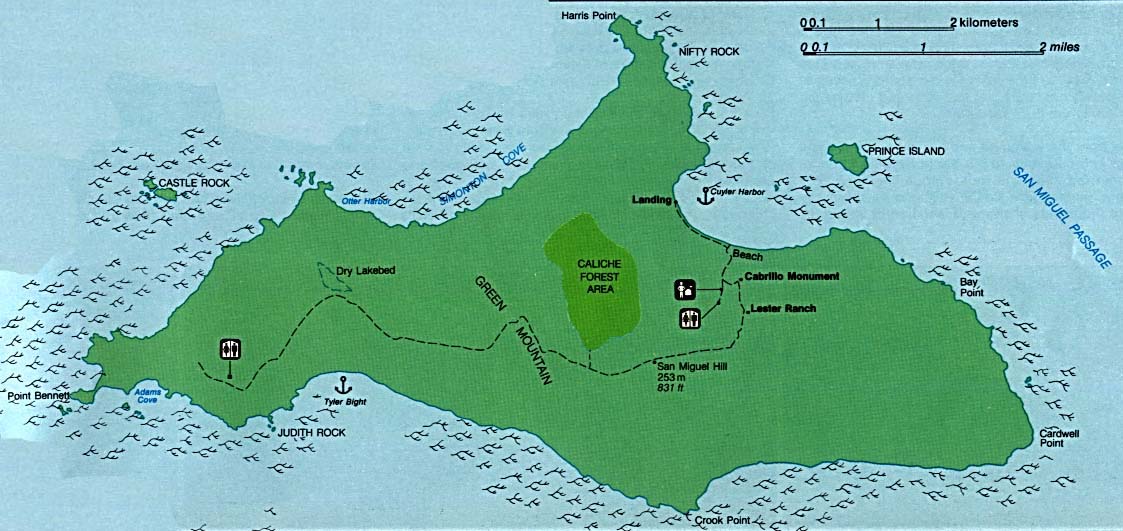
Map by California Parks
CopyRight @ 1997
San Miguel is beyond the shadow of Point Conception and so is the most exposed of the Channel Islands. There is a lot of weather up there. It can come down all the way from Alaska with nothing in the way. Usually, there is far too much wind and wave for a dive boat to make the long trip there, but when it is calm enough, San Miguel offers special diving.

Map by California Parks
It is hard to explain San Miguel
Island. It is very different from the rest of the Channel Islands. All
the rest of the islands have a Southern California feel. It is a place
of mists and chill that is not always warmed by the Southern California
sun. San Miguel, with its often times green, nutrient filled waters, has
more of a Northern California feel. It gets a lushness of life that is
not ordinarily found in Southern California waters. Also the bottom is
generally different. There are more abrupt dropoffs and pinnacles
everywhere. It is some of the most spectacular diving that a person can
visit... when the boat makes it.
Because of its remoteness, it is a hunters dream. There are still large
fish, lobster, abalone and scallops that the commercial fishers have not
had time to completely pillage and few enough divers have gotten to it
to have a big impact. It is one of the few places left where there are
the large mature male sheepsheads.
For of a variety of reasons, San Miguel must be pretty much considered an advanced dive location.
There are a number of different types of diving there. There are the open ocean pinnacles of Wilson and Richardson Rocks, the misty coves of the frontside and the offshore boulders of Wycroff Ledge. Also there is the wild spaces of the Foul and huge sand areas where the halibut hunters roam.
Both Wilson and Richardson Rocks are actually the tops of
offshore mountain ridges that come just above the surface in places.
The thick growth of filter feeders that blanket the rocks in open
currents here make it a photographers dream, but it is far too
exposed for abalone, lobster or even much in the way of fish. There
are even areas that support fields of delicate white Metridium anemones
and huge scallops are common. This is vertical wall diving on the
side of pinnacles, where you come to the top of a pinnacle that you are
diving on and must guess where the next one is before swimming into the
green to find it.
Wilson Rock is a pretty substantial divable area extending perhaps a
mile parellel to the north side of the island, about a mile offshore.
It drops off quickly to deep water on both sides though.
Richardson Rock is the last stop before Hawaii. They say the deal is
this. The sharks won't go to Wilson Rock and the divers won't go to
Richardson Rock. Normally, a diver will never see sharks out there,
but if the visibility is exceptional, they will see an eye full of
them.
Wycroff Ledge is actually just part of what would be called the backside. It is actually the south east side of the island and is a large area of lush, excellent diving. It is extremely exposed to large swell coming from the south though. When diving there, if the bottom suddenly blurs, it is silt lifted by the leading edge of the pressure wave of an extremely large swell passing above. It is time to hold on or crawl in a hole.
On the Northwest side is a large cove miles across, with Prince Island towards the outer center of the cove. This is the misty cove where sea mists drift along sandy windswept shores. It is a huge dive area with lush kelp and incredibly varied terrain.
If it is a truely calm day, a boat can go all the way up the frontside and staying close to shore, it can pass inside of Castle Rock into the Foul Area simply known as the Foul. The many pinnipeds in the area have also caused it to be known as Shark Park. This is the farthest corner of the island at the west end. It's sort of a hazardous place with sand bars that move around and rocks sticking up way out there. From inside the Foul it looks like it is a complete bowl perhaps a mile across, ringed by the island and numerous offshore wash rocks. It makes for a vast area of reef at very divable depths. It is the last place that the commercial fishers got to. I have heard that the Coast Guard used to refuse to try to go in there for a rescue due to the hazards. I'm not sure about that now. It's just one of the toughest spots to get to at the Channel Islands and it shows it. The diving is great just because it is hard for divers to get there. There are still many red abalone, lobster, red snapper, sheepsheads, calicos and other rockfish.